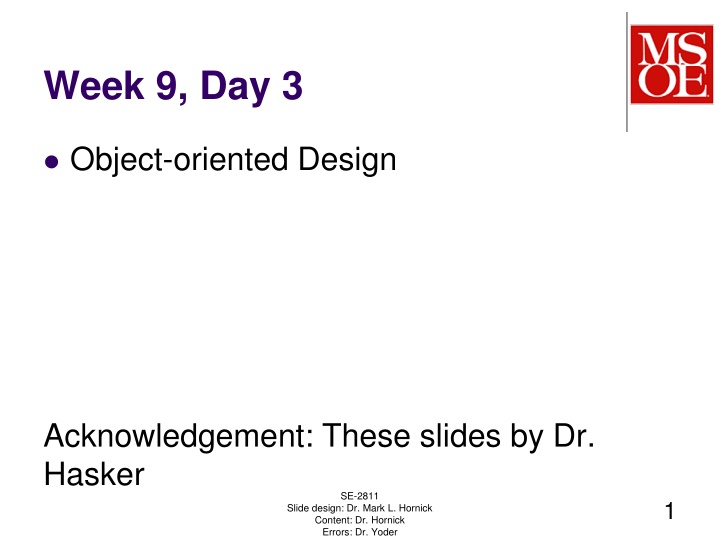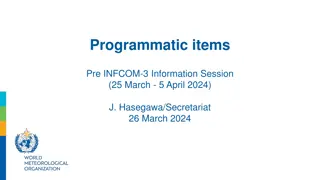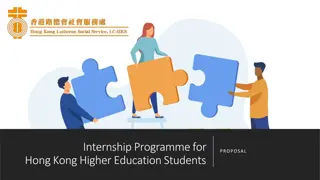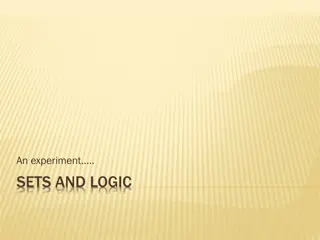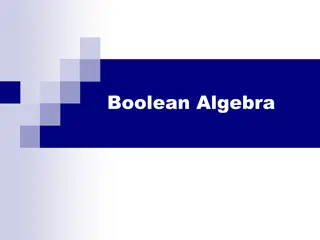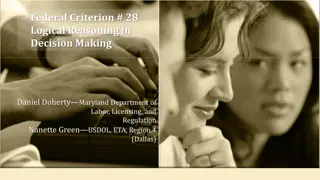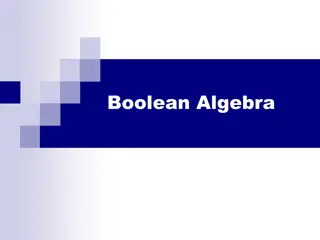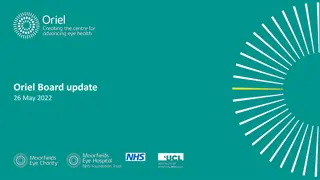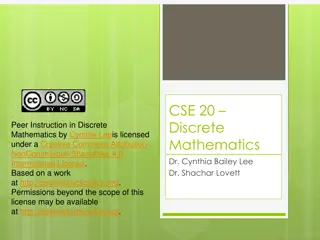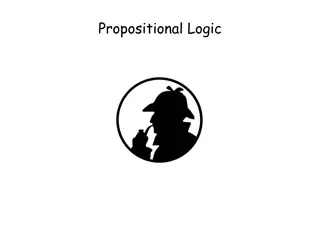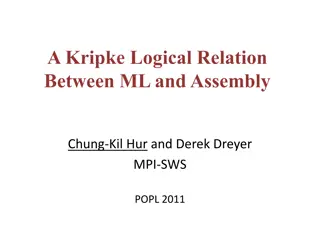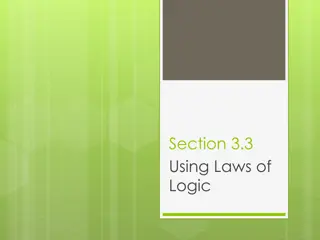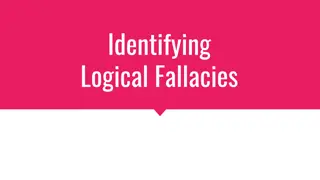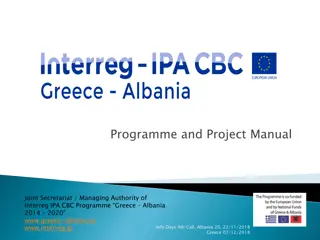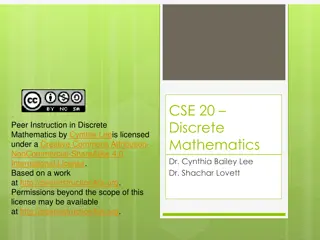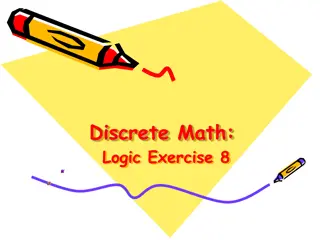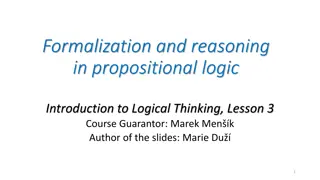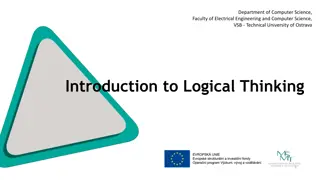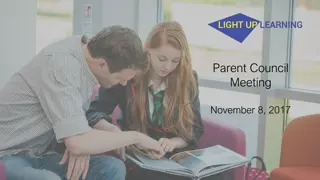Logical Approach to Programme Management
A systematic process integrating cause-and-effect relationships, stakeholder analysis, problem identification, and strategic solution selection for sustainable project success.
Download Presentation

Please find below an Image/Link to download the presentation.
The content on the website is provided AS IS for your information and personal use only. It may not be sold, licensed, or shared on other websites without obtaining consent from the author.If you encounter any issues during the download, it is possible that the publisher has removed the file from their server.
You are allowed to download the files provided on this website for personal or commercial use, subject to the condition that they are used lawfully. All files are the property of their respective owners.
The content on the website is provided AS IS for your information and personal use only. It may not be sold, licensed, or shared on other websites without obtaining consent from the author.
E N D
Presentation Transcript
Week 9, Day 3 Object-oriented Design Acknowledgement: These slides by Dr. Hasker SE-2811 1 Slide design: Dr. Mark L. Hornick Content: Dr. Hornick Errors: Dr. Yoder
Whats an object? What does it mean to say Java is object-oriented? 1st year: oo programming; 2811: object-oriented design So what s an object? What are the elements of a class? State Capture information, provide it on request, record events Student: name, id, classes taking, GPA Behavior Operations that do things Student: compute GPA for term, add a class to schedule Responsibility What the object provides to the rest of the system Student: record classes taking, progress
Whats an object? What are the responsibilities of A house? A roof? door? window? Bank account? Student record in registration system? How many responsibilities should a class have? Textbook: just one! What would happen if Student had just one responsibility? Responsibilities: clear, limited, but complete! When would it make sense to have just one responsibility?
Whats an object? What is the responsibility of java.util.Date? See first line of Java API
Whats an object? What is the responsibility of java.util.Date? See first line of Java API Does this match something in the physical world? A concept, not an object! Identity Something you can point at An address: this is just some text A building: there is a specific building at a specific location Helps distinguish between pieces of information about something (color, name, identification number, temperature) and the things that have that information (people, hurricanes, cars, boats) Objects without identity: attributes
What characterizes an object An object is something with Responsibility Identity Behavior State
What characterizes an object An object is something with Responsibility Identity Behavior State But where do objects come from? How do we know we have all the ones we need? Consider a simple example
How to build a system? Meal Wheel As a hungry student, I want my phone to randomly select from different restaurants so I know where to eat. As a picky student, I want my phone to suggest close restaurants that serve sashimi so I can choose a place to eat within 10 minutes walk. As a restaurant owner, I want to distribute menus to potential customers. As a restaurant owner, I want potential customers to know of dietary restrictions that I support so I can attract customers who do not eat particular foods. What classes should be in this system? Why?
Domain classes Possible classes: table of restaurants to GPS coordinates, table of restaurants to menus, table of dietary restrictions to menu items But if add tracking popularity, wait times, etc., will need to add more tables Solution: domain classes Classes that are part of the problem space Alternative: solution space Classes that are in a particular solution Why prefer domain classes? Solution independent less likely to change to support new features Natural: these are the entities that form the problem to solve
How to identify domain classes? Solution 1: just sit there and think them up Solution 2: mine the stories/scenarios/requirements Objects: lead to classes Verbs: actions
Finding classes: Meal Wheel As a hungry student, I want my phone to randomly select from different restaurants so I know where to eat. As a picky student, I want my phone to suggest close restaurants that serve sashimi so I can choose a place to eat within 10 minutes walk. As a restaurant owner, I want to distribute menus to potential customers. As a restaurant owner, I want potential customers to know of dietary restrictions that I support so I can attract customers who do not eat particular foods.
Finding classes: Meal Wheel As a hungry student, I want my phone to randomly select from different restaurants so I know where to eat. As a picky student, I want my phone to suggest close restaurants that serve sashimi so I can choose a place to eat within 10 minutes walk. As a restaurant owner, I want to distribute menus to potential customers. As a restaurant owner, I want potential customers to know of dietary restrictions that I support so I can attract customers who do not eat particular foods.
Finding classes: Meal Wheel As a hungry student, I want my phone to randomly select from different restaurants so I know where to eat. As a picky student, I want my phone to suggest close restaurants that serve sashimi so I can choose a place to eat within 10 minutes walk. As a restaurant owner, I want to distribute menus to potential customers. As a restaurant owner, I want potential customers to know of dietary restrictions that I support so I can attract customers who do not eat particular foods. Noun identification method Classes: groups of objects w/ RIBS Attributes: simple data Methods: actions on objects
Other sources of classes Active objects Objects which consume, produce others; objects which control actions Passive objects Data storage, inputs, basic output Example: light switch, sensors, printers Real-world items domain classes discussed earlier Physical devices things with internal state to capture Transactions sales receipt, todo item Persistent information: configuration User interface elements menus, dialogs
Sound designs RIBS: test whether a thing is an object or an attribute, when to make 2+ objects Start with domain classes These persist across problem changes Capture things clients, users will recognize Capture requirements that go with those items Add containers, architectural elements Decisions about time/space/complexity tradeoffs Databases, network communications, GUI elements Introduce design patterns, refine These generally reduce coupling, increase flexibility May REMOVE classes from previous steps Be careful about removing domain classes! 1. 2. 3.
Common mistakes doit class: does everything Generally surrounded by lots of passive objects VERY low cohesion System class no need to document main()! Often becomes a doit class Classes for actions parser , artificial intelligence , list maintainer Roll these into domain objects! Patterns excepted! Poor inheritance If A extends B, then anywhere a B can appear, so can an A Liskov Substitution Principle Never violate contracts
Review Noun identification method RIBS Other sources for classes Doit, passive classes and their dangers Liskov Substitution Principle
SE-2811 18 Dr. Mark L. Hornick
Exercise In the user stories on the next slide, identify Domain-level objects Attributes Behaviors / methods for the objects SE-2811 19 Dr. Mark L. Hornick
Class Exercise Consider the user stories below: As a user, I can backup my entire hard drive. As a power user, I can specify files or folders to backup based on file size, date created and date modified. As a user, I can indicate folders not to backup so that my backup drive isn't filled up with things I don't need saved. https://www.mountaingoatsoftware.com/agile/user-stories
